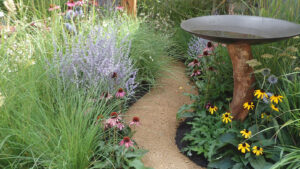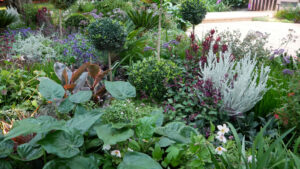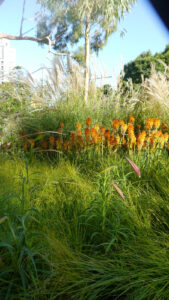The importance of plant families in floral composition
By Patrick Regnault
When designing a garden a lot of time and thought are put into plant selection. The floral composition focuses on size, blooming season, foliage variation and the colour of the flowers which will give the garden its aesthetic appeal, its texture and its depth.
If we take plants of different genera but from very few families, we can arrive at a beautifully balanced garden, and this is what we see in many, yet, the diversity in plant families in ornamental gardens seem to be unknowingly overlooked or perhaps simply ignored. The advantages in using an extensive palette of plants from a range of plant families and varies from plant health to vertebrate diversity, soil fauna and flora, and even human health benefits.

Pest and disease resistance increases with the quantity of plant families used, thus reducing the chemical load on the garden and its occupants. Using few plant families is akin to mono-cropping for a garden. Pests and pathogens can be family specific and when this happens in a planting where plant families are limited, we can see mass casualties and a failed landscape. When numerous genera from many plant families are used, we minimise that risk and we can even increase plant health by attracting a larger collection of beneficial insects and fungi which will do the protection work for us and limit the amount of pesticide applied.
Plant species and plant family diversity impacts soil biodiversity. Plants shed vegetation matter onto the soil which is then used by different organisms to feed on. Different plant litter types will increase the soil micro-organisms range of species. The larger the range, the better the health of the soil and the plants’ ability to access nutrients through an improved root system, in turn, improving drought resistance. A win for the gardener, the plants and the soil food web.
Pollinators also benefit from flowering plants from various families. Flower shape is a key factor in the attraction of pollinators. A study done in 1996 in Israel, shows that beetles were associated with large bowl-shaped flowers, and small bees were more attracted to small flowers with a broken outline. At a time where pollinators are thought to be in decline, we as horticulturists need to be aware of the practical way we can help.


Greater plant diversity has a direct effect on human health. It seems that there is a correlation between floral diversity and immune system regulation, as well as physical and psychological well-being. Interestingly, this health benefit is not limited to our species as the pollinators health also greatly improves.
The aesthetic benefits seem evident, a greater assortment of plant families means more shapes and forms to choose from. This may require more time spent on the design and plant selection and perhaps a rethink of our aesthetic ideas. This could be the beginning of a new garden design movement perhaps?
It may be necessary for the horticultural sector to push for a greater understanding of all aspects of botany in the vocational sector. Bringing back a more thorough teaching of taxonomy, and linked to an understanding of its practical use in garden design, plant health and general biodiversity benefits would seem the logical step. Professional development can help the established horticulturists, landscapers and designers to refresh their memory of botany, taxonomy and plant systematics. This is the role of professional organisations, and some, like the Australian Institute of Horticulture, run webinars on the subject. Unfortunately, the VET sector does not seem to attach as much importance to taxonomy as it once did. Perhaps it would be an attractive subject if the practical applications were explained to the students.
Gardens, parks, bush regeneration all require the professional practitioner to understand the ramification of their plant selection on various levels. There is a clear need in our green spaces to effectively achieve the goal of enhanced biodiversity, which is much talked about. We need to make use of our botanical knowledge and familiarise the general public with the subject and remove the elitist misconception of botany.
Patrick Regnault FAIH RH0062
Interactive Landscapes
E: patrickregnault@hotmail.com
